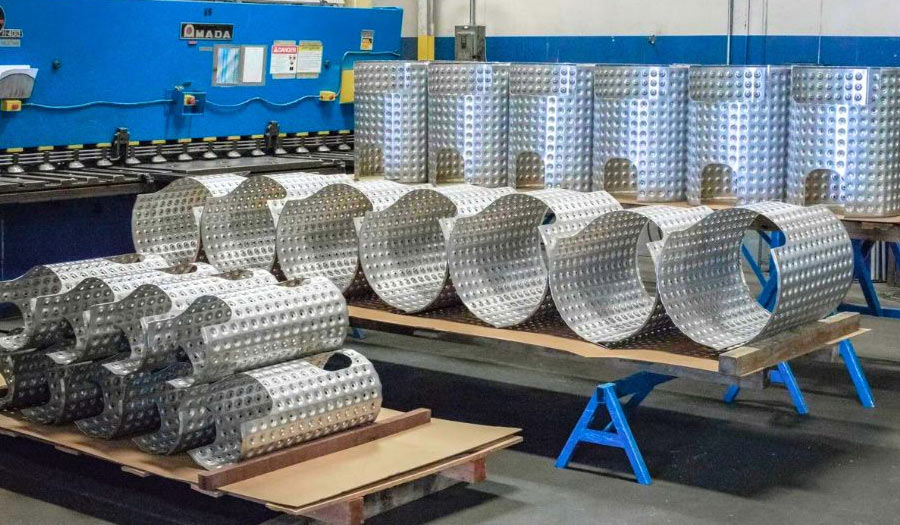Temperature control is one of the most important factors in the fermentation process. A jacket is a common temperature control device and is widely used in fermentation tanks. Especially under different temperature requirements, the appropriate jacket structure can effectively improve the heat exchange efficiency and ensure the smooth progress of the fermentation process. Among the many jacket types, dimple jackets, and coil jackets are two common and widely used designs.
What is a Fermentation Tank Dimple Jacket?
A Gistingstank Dimple Jacket is a heat exchange system commonly used in fermentation tanks and other reactors. Its inner surface presents a “dimple”-like concave structure, similar to a pit jacket, but its specific design is different. The dimple jacket mainly uses these concave surfaces to enhance the fluid turbulence during the heat exchange process, thereby improving the heat exchange efficiency and maintaining the uniformity of the temperature in the reactor. It is often used in fermentation processes that require precise temperature control, especially in industries such as food, pharmaceuticals, and brewing.
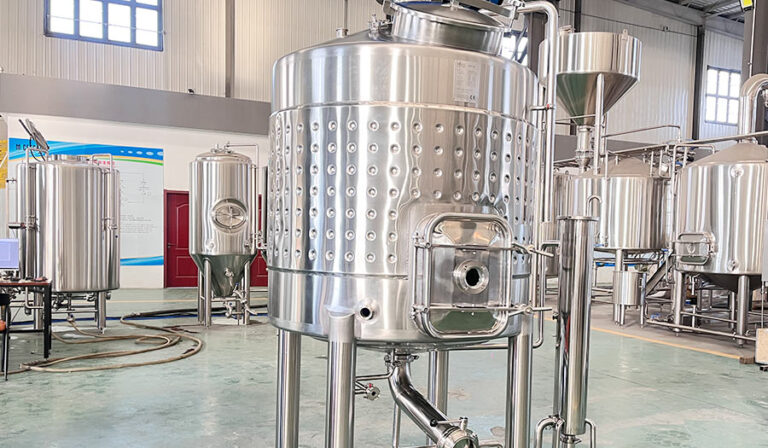
Structural features of dimple jackets
The basic structure of a dimple jacket is similar to other types of jackets, usually consisting of two layers of metal plates or pipes, with the inner layer being a surface with dimple-shaped depressions. The inner surface of a dimple jacket is designed with multiple small dimples, usually circular or elliptical. The outer layer is a metal outer wall that provides support, and the inner layer is used to inject heat transfer media, such as water or steam.
Compared with ordinary flat jackets, dimple jackets increase the contact area between the hot fluid and the fermentation tank wall through these dimple surfaces, promoting more efficient heat transfer. The biggest feature of the dimple design is that it enhances the turbulent effect of the fluid, which means that the hot fluid will not only transfer heat during the flow process but also enhance the heat exchange contact with the tank wall and improve the heat transfer efficiency.
How does a dimple jacket work?
The working principle of a dimple jacket is based on the dual effects of heat convection and heat conduction. When a hot fluid (such as water or steam) passes through the dimple area of the jacket, the fluid will produce a turbulent effect in these areas due to the physical properties of the dimple surface. This turbulence promotes the heat exchange process between the hot fluid and the outer wall of the tank, allowing heat to be transferred from the hot fluid to the fermenter more quickly and evenly, thereby effectively regulating the temperature inside the fermenter.
Specifically, when the hot fluid flows in the jacket, the flow rate is affected by the surface of the dimples, and the flow rate of the fluid becomes more unstable, forming turbulence. The generation of turbulence increases the contact area between the fluid and the inner wall of the jacket, and the heat exchange effect is also improved. Therefore, the dimple jacket provides higher heat transfer efficiency than the traditional flat jacket or the simple spiral winding jacket.
Advantages of Dimple Jacket
Improve heat exchange efficiency
The dimple jacket increases the contact area between the hot fluid and the outer wall of the fermenter through its special dimple shape. The dimple design enhances the turbulence effect of the fluid, thereby improving the heat transfer efficiency. At the same fluid flow rate, the dimple jacket can provide a stronger heat exchange effect.
Reduce thermal gradients
The dimpled jacket ensures an even distribution of heat, allowing the hot fluid to come into contact with all parts of the fermenter more evenly. This uniformity helps reduce thermal gradients, making the temperature distribution in the fermenter more stable and avoiding inconsistent fermentation results caused by large temperature differences.
Suitable for high-viscosity fluids
The dimple jacket is particularly effective for high-viscosity fluids because the dimple design can promote turbulent flow of the fluid, avoid poor flow due to high viscosity, and ensure efficient and uniform heat transfer.
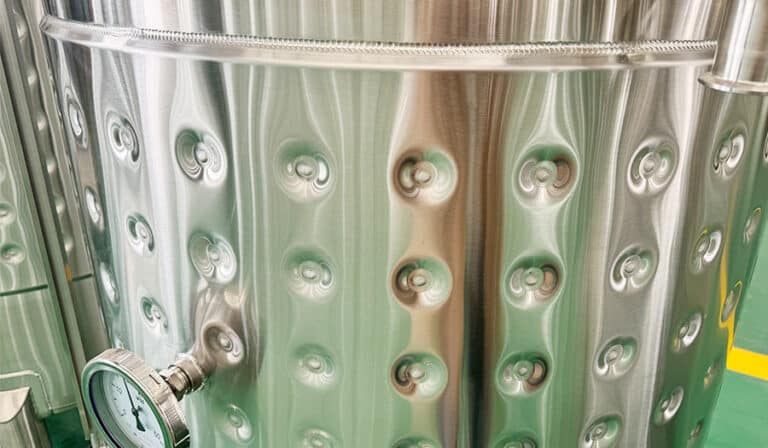
Significant energy-saving effect
Since the dimple jacket can significantly improve the heat exchange efficiency, the heat input required by the fermentation tank is reduced, thereby reducing energy consumption and achieving energy energy-saving effect.
Simple structure, easy to clean
Although the structure of the dimple jacket has a pit design, it still maintains a relatively simple shape. Compared with other more complex jacket types, the dimple jacket is easier to clean and maintain. In addition, the fluid passage of the dimple design is relatively simple and not prone to deposition or clogging, which is beneficial to the reliability of long-term operation.
What is a fermenter coiling jacket?
A coiling jacket is a common heat exchange device, usually made of a metal tube bent into a spiral or ring shape to form a pipeline for fluid flow. Coiled jackets are widely used in fermenters, reactors and other equipment for heat transfer in temperature control systems. Its working principle and structure are relatively simple, but it can also provide efficient heat exchange effects.
What are the characteristics of the coiling jacket?
The main structure of the coiling jacket is composed of a metal tube (usually stainless steel) bent into a series of spiral or annular flow channels. The fluid flows through these pipes to exchange heat. The advantages of the coiling jacket are that the design is relatively simple, easy to manufacture, and can provide good heat exchange performance.
Coiling jackets can generally be divided into single-layer and multi-layer forms. Single-layer coiling jackets are suitable for occasions with lower heat exchange requirements, while multi-layer structures can increase the heat exchange area and improve efficiency. The coiling jacket can control the flow pattern of the fluid by adjusting the diameter, number of layers, and flow rate of the pipe, thereby affecting the heat exchange effect.
Working principle of coiling jacket
The working principle of the coiling jacket mainly depends on the heat exchange process. Specifically, the hot fluid flows through the pipe in the coiling jacket, and the heat is transferred to the outer wall of the fermenter through the pipe wall, and then transferred to the material or liquid in the tank through the outer wall of the fermenter. The process of heat transfer is based on the principles of heat conduction and heat convection.
- Heat conduction: The hot fluid conducts heat through the metal pipe, and the temperature of the pipe wall is transferred to the outer wall of the fermenter.
- Thermal convection: Heat is transferred through the outer wall of the fermentation tank to the liquid or material in the tank, and then the heat is transferred through convection inside the liquid to adjust the temperature inside the fermentation tank.
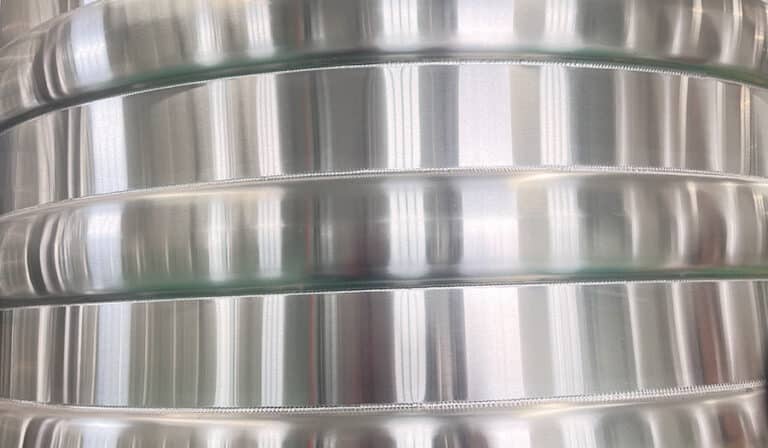
Advantages of coiling jacket
Efficient heat exchange
The coiling jacket increases the contact area between the hot fluid and the outer wall of the fermenter through the spiral pipe design, thereby improving the efficiency of heat exchange. During the flow of the hot fluid, the increase in flow rate and temperature difference allows the heat to be transferred quickly, maintaining the temperature in the fermenter stable.
Simple and reliable structure
The structure of the coiling jacket is relatively simple, usually consisting of a section of metal pipe, which is easy to manufacture and install. There is no complex mechanical structure, which makes it more durable, with a low failure rate, and suitable for long-term operation.
Flexibility and adaptability
The coiling jacket can be customized according to actual needs to adapt to different fermenter sizes and shapes. Whether it is a small laboratory fermenter or a large industrial fermenter, the coiling jacket can provide stable temperature control performance.
Gemakkelijk schoon te maken en te onderhouden
Due to its simple pipe structure, the coiling jacket is easier to clean than other more complex heat exchange systems. In the food and pharmaceutical industries, the hygiene requirements of the equipment are high, and the coiling jacket is widely used because it is easy to clean.
Significant energy-saving effect
The coiling jacket can maintain the required temperature at a lower energy consumption through efficient heat exchange, reducing heat waste, and thus has a good energy-saving effect.
Suitable for large-flow heat exchange
The coiling jacket is suitable for large-flow hot fluid flow and can effectively cope with large-scale heat exchange needs. For example, in industrial fermentation processes, the coiling jacket can handle large heat loads and ensure that the fermentation tank can maintain a stable temperature under high loads.
Choose a dimple jacket or a coiling jacket.
Fermentation process requirements
If the fermentation process requires strict temperature control, the dimple jacket is usually a better choice. The dimple jacket can more effectively promote heat exchange, reduce temperature fluctuations, and ensure uniform temperature in the fermenter by increasing the contact area between the fluid and the tank wall. It is particularly suitable for high-viscosity fluids or occasions where temperature control requires very precise.
In contrast, the heat exchange efficiency of the coiling jacket is relatively stable when the fluid flow rate is high or the temperature difference is large, but it may not be as good as the dimple jacket in terms of precise temperature control. The coiling jacket is suitable for those occasions with lower requirements for temperature control accuracy, such as large flow and high temperature difference.
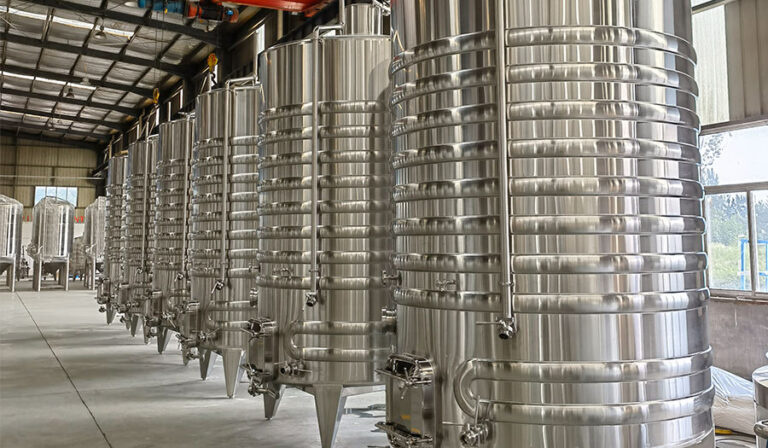
Flowability
The dimple jacket is particularly effective for high-viscosity fluids. Its simple design can promote turbulence in the flow of the fluid, avoid poor flow caused by high viscosity, and ensure uniform heat transfer. Therefore, if the liquid in the fermentation process has a high viscosity (such as sauces, syrups, or brewing materials), the dimple jacket will be a better choice.
For low-viscosity fluids, the coiling jacket can also provide a sufficient heat exchange effect. The flow channel design of the coiling jacket is relatively simple, and the fluid flow is relatively smooth, which can meet the heat exchange requirements of low-viscosity fluids.
Heat exchange efficiency
- Dimple jacket: The dimple jacket can promote fluid turbulence through the design of the pits, thereby enhancing heat transfer. This design can improve the heat exchange efficiency, especially at low flow rates and high viscosities. It can also effectively reduce thermal gradients and temperature fluctuations to ensure uniform temperature in the fermentation tank.
- Coiled jacket: The heat exchange efficiency is closely related to the fluid flow rate and temperature difference. When the fluid flow rate is large, the coiling jacket can provide relatively high heat exchange efficiency, especially at high flow rates. However, the heat exchange effect of the coiling jacket at lower flow rates is relatively poor because the fluid flow is relatively stable and lacks turbulence effects. Therefore, the coiling jacket is generally suitable for applications with large flow rates and high temperature differences.
Industry requirements
- Dimple jacketsDimple jackets are widely used in fermentation processes that require precise temperature control, especially in the brewing industry, pharmaceutical industry, and food processing industry.
- Coiled jackets are suitable for large-scale industrial production and processes with less stringent temperature control requirements.
Samenvatting
Dimple jackets and coiling jackets are two common fermentation tank temperature control jacket designs, each with unique advantages and applicable scenarios. The dimple jacket improves the heat exchange efficiency by enhancing the fluid turbulence effect, and is suitable for processes that require precise temperature control; while the coiling jacket is widely used in large flow heat exchange occasions due to its simple structure and high flexibility. Choosing the right jacket type can optimize the temperature control effect, improve production efficiency, and ensure the smooth progress of the fermentation process according to the actual needs of the fermentation process.




